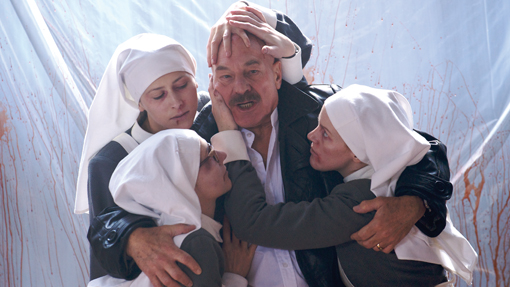Mark Thornton Burnett, Queen’s University, Belfast, author of Shakespeare and World Cinema, explores the contemporary significance of Shakespeare cinema outside the Hollywood and UK mainstream.
 About the Author: Professor Mark Thornton Burnett is Director of the Kenneth Branagh Archive, Chair of Research Committee and Research Director for the School of English and research interests include all aspects of the English Renaissance in its own time and beyond. Recent publications include Filming and Performing Renaissance History (Palgrave Macmillan, 2011); Shakespeare and World Cinema (Cambridge University Press, 2012). Currently he is co-authoring Great Shakespeareans: Welles, Kozintsev, Kurosawa, Zeffirelli (Continuum, 2013) with Courtney Lehmann, Marguerite H. Rippy and Ramona Wray and working on a new project on the social and cultural history of Hamlet on film.
About the Author: Professor Mark Thornton Burnett is Director of the Kenneth Branagh Archive, Chair of Research Committee and Research Director for the School of English and research interests include all aspects of the English Renaissance in its own time and beyond. Recent publications include Filming and Performing Renaissance History (Palgrave Macmillan, 2011); Shakespeare and World Cinema (Cambridge University Press, 2012). Currently he is co-authoring Great Shakespeareans: Welles, Kozintsev, Kurosawa, Zeffirelli (Continuum, 2013) with Courtney Lehmann, Marguerite H. Rippy and Ramona Wray and working on a new project on the social and cultural history of Hamlet on film.
As the opening decade of the twenty-first century recedes, the discipline of Shakespeare on film has rooted itself firmly in the educational curriculum. Works such as Kenneth Branagh’s Henry V (1989) and Baz Luhrmann’s William Shakespeare’s Romeo + Juliet (1996) are a staple of university courses on Shakespeare and his film manifestations. Yet, strikingly, in commentary on Shakespeare films, there has been no corresponding move to detail how, where and with what results the plays are translated into the idiom of world cinema. The revival of the Shakespeare film genre in the period from the late 1980s onwards has excited a plethora of criticism, but, almost without exception, attention focuses on exclusively English-language or Anglophone productions.
I wrote Shakespeare and World Cinema, which has recently been published by Cambridge University Press, to see what might emerge when we look beyond a US-UK axis of interpretation. What I came across was a cornucopia of examples, with Shakespeare films from Africa, Brazil, France, Germany, India, Malaysia, Sweden, Tibet, Venezuela and elsewhere that constituted a distinctive and important body of material. I thrilled to a Sámi-language adaptation of Macbeth (dir. Bo Landin and Alex Sherpf, 2004) made in the Arctic Circle that canvasses questions about indigenous rights and minority tongues; I was inspired by adaptations of Romeo and Juliet that, set in the Rio de Janeiro favelas, countered popularized images of the drug wars; and I paused for reflection after viewing Prince of Himalayas (dir. Sherwood Hu, 2006), a Tibet-based adaptation of Hamlet invigorated by its message of forgiveness, Buddhist ideas of reincarnation and epic aesthetics. Not every film I encountered was a high production venture. For instance, Gebede (dir. Nam Ron, 2002) is striking as an adaptation that, utilizing dank interiors and empty malls, recasts Julius Caesar as a tussle for authority centred on Kuala Lumpur’s underground punk rock scene.

The fateful banquet scene from Macbeth (dir. Bo Landin and Alex Scherpf, 2004), a Sámi language adaptation of Shakespeare’s play set in the Arctic Circle. Courtesy of Bo Landin, Alex Scherpf and Scandinature Films.
Other films showcased unexpected locations for the work of Shakespearean reinvention. It was a revelation to realize that Mexico has a venerable Shakespearean lineage, as reflected in Huapango (dir. Iván Lipkies, 2004), an adaptation of Othello that, making a virtue of the folklore of the Huasteca region, takes a colourful dance competition as its dominant conceit. No less suggestive here is the southern Indian film, Kannaki (dir. Jayaraaj Rajasekharan Nair, 2002), an adaptation of Antony and Cleopatra that challenges ‘Bollywood’ via saturated landscape shots of Kerala’s picturesque paddy fields and waterways. In these and related kinds of interpretation, a localized mise-en-scène is a key to understanding. Hence, in Makibefo (1999) and Souli (2004), adaptations of Macbeth and Othello respectively, French director Alexander Abela finds in the traditional symbols of Madagascan tribal culture – charms, an ox and an ocean-going pirogue – apt ciphers for Shakespearean metaphor. All in all, I learned about more than seventy recent non-Anglophone Shakespeare films, with almost as many points of origin, in an experience that allowed me to appreciate the role that Shakespeare continues to play in the international marketplace.
How does an interested party acquaint himself or herself with such works? Richard Burt’s magisterial Shakespeares after Shakespeare: An Encyclopedia of the Bard in Mass Media and Popular Culture is a fine place to start for researchers, although not always as full in its provision of detail as one might like.[1] This work has been superseded by the splendid online database – an ‘International Database of Shakespeare on Film, Television and Radio’ – hosted by the British Universities Film and Video Council, which, as well as being user-friendly, is denser and far more sustained in furnishing information.[2] Then there are the other, more serendipitous, means – the word-of-mouth, the friendly tip-offs and the idle surfing of a search engine which, in haphazard and unpredictable ways, can yield precious quarry. But how does one engineer a viewing of an individual filmic example once it has been identified? Online environments offer one possibility. A resource such as ‘Global Shakespeares’, hosted by the Massachusetts Institute of Technology, is tremendously exciting in bringing before audiences extracts from theatrical performances of Shakespeare and, to a lesser extent, Shakespeare films from around the world.[3] The concept of a library of Alexandria is suggested in the utopian ideal of a digital age that allows all Shakespeare films to be more readily obtainable. In this way, objections to a refiguring of the field, which take the form of instancing ‘availability’ or ‘obscurity’ as barriers to change, may be reduced in ubiquity, as we enter a phase where such cultural-national and temporal markers have been absorbed within, and questioned by, the conversations of cyber space.

Souli/Othello (Makena Diop) confronts Yann/Iago (Aurélien Recoing) in Souli (dir. Alexander Abela, 2004), a Madagascar-set adaptation of Shakespeare’s Othello. Courtesy of Alexander Abela.
Such connections as there are between Shakespeare scholars and technology at present, however, insist upon a rather more sombre picture, and we have not yet arrived at a place of free exchange and instant cinematic gratification. The filmography to Shakespeare and World Cinema includes some titles that are commercially available, but the fact remains that many of the examples discussed could not be located via conventional means. Other ways of acquiring hard-to-find titles had to be explored. Beginning with the film festivals, and tracing a moment of appearance, was one method. Another was going back to source: I have tried saying ‘Good Morning’ in Malayalam, ‘Many apologies for bothering you’ in French, and ‘Thank you very much’ in Brazilian Portugese. Chasing an item, and wishing to pin down a particular director, I resorted to the old-fashioned telephone. I had pleasant chats with proud and some less proud mothers-in-law. I got to know some grandfathers. I interrupted daily routines, dinner-tables and more than one baby being put to bed, generally making a complete nuisance of myself. Eager to secure one elusive DVD, I asked a visiting student – now a friend – to act as go-between in Hyderabad. In an extraordinary concatenation of coincidences, my friend realized that he and the son of the director I sought were both to feature in a local radio station broadcast; from this brief encounter a further meeting was set up and a time and place, for the handover of the film, agreed. This was only one of the many moments when, in the writing of the book, I became acutely self-conscious about the accidents of what is written about and what is not and about the implications of participation in the global traffic of cinema.
In several instances, the ‘how’ of acquisition, and the subscription to personal contact, fortuitously led to a face-to-face interview, and it will be apparent from the book that one its attendant methodologies is the inclusion of the director’s voice as a route to analysis. But, in those exchanges between myself and the director, English was not always the default position; translators and mediators were used, and I am aware, for all I cited ‘original’ perspectives and aspirations, other elements – filters and interpreters – were part of the conversation. As part of an effort to circumvent what was lost – and gained – through translation, I watched a number of the films discussed in Shakespeare and World Cinema with native speakers. Certainly, I tried to treat the traversed texts of Shakespeare with a due regard to their entanglements. In the same way that some of my examples highlight issues of voice and authority, so was I enjoined to recognize the parts we academics play in the increasingly diversified – yet still insufficiently global – world of Shakespearean studies.
Mark Thornton Burnett
Footnotes: